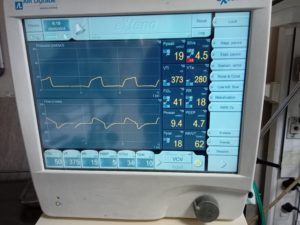The ventilator provides complete life support for the patient with post-surgical and ARDS etc. Non-invasive ventilation intended for the use of positive airway pressure ventilation. see more for modes of ventilation in the post how to use ventilator
Minimum tidal volume ventilation delivered shall be equal to or greater than the 20 ml for adults patients and 2 ml for the infants /neonates
Check the ventilator with the resuscitation bag using the PEEPand high concentration oxygen.
Scope: Patients with respiratory distress are supported with ventilatory support to maintain optimal blood oxygen levels.
How to use ventilator: Prechecking and Precautions
Do not use the exhaust port of the expiratory valve for the spirometry.
Do not use any liquid items on the Hamilton ventilator, no spillage or liquid item on the ventilator console
Avoid using flammable agents or material on the ventilator setup.
Don’t use the contaminated items, oil or grease on the ventilator.
Highly compressed oxygen together with flammable sources could lead to a spontaneous explosion.
Do not use the high-pressure hose for the ventilator pipelines and the gas hoses
Do not use the tubing with antistatic or electrically conducted tubing
In case of fire, stop the ventilation and disconnect all the accessories and disconnect from the electric circuit.
Ventilation safe protocol
Preoperational test
If the test fails
Do it again with the checking of the connection and supply
Again if fails call the service engineer
(S)CMV +/APVCMV- synchronized controlled mandatory ventilation
SIMV +/APV SIMV – synchronized intermittent mandatory ventilation
Volume modes(adaptive pressure )
Combination of the pressure and volume targeted ventilation
Pre Procedure:
Informed consent Decision to give ventilatory support is based on parameters which may include:
Arterial blood gas (ABG)
Chest X-ray
Clinical Status Ventilator connected to test lung Ventilatory parameters are set Other requirements for ventilatory support are primed as per patient condition:
Ambu bag with oxygen connection
Appropriate size endotracheal tubes
Laryngoscope
Suction apparatus
Cardiac/ critical care monitor
Pulse Oximetry monitored continuously. During Procedure: Patient sedated and paralyzed if necessary Intubation performed as per the clinical condition of the baby and under strict aseptic condition. The position of the tube checked clinical/chest x-ray Cuff inflated in appropriate cases.
Cuff pressure maintained within 25 to 30 cm of H2O Tubes are fixed to the body of the baby with plaster. Patient connected to the ventilator and parameters rechecked. Saturation monitored using a pulse oximeter. Vitals monitored continuously Suctioning performed periodically
Post Procedure: Once the patient stabilized, ventilatory requirements weaned Extubation planned based on:
Clinical indicators
Ventilatory parameters
ABG
Respiratory indices
Modes in Ventilator
Pressure modes –conventional pressure-controlled modes of the ventilation
PCV + pressure-controlled ventilation
PSIMV+ pressure controlled synchronized intermittent ventilation
SPONT spontaneous pressure supported ventilation
CPAP controlled positive airway pressure
DUO PAP dual positive airway pressure
APRV airway pressure release ventilation
ASV Adaptive support ventilation ( this is only for the adult’s patients )
Non-invasive ventilation modes
NIV Non-invasive ventilation
NIV ST Non-invasive ventilation spontaneous
n CPAP PS neonatal modes nasal continuous positive airway pressure
Pressure in cmh2o
m bar or hPa
1 m bar =1 hPa =1.016 cm h2o